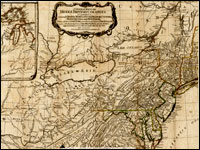Scotchtown [VA]
Patrick Henry, orator of the American Revolution and first governor of Virginia, made his home at Scotchtown from 1771 to 1778.
The site offers exhibits and tours.
Patrick Henry, orator of the American Revolution and first governor of Virginia, made his home at Scotchtown from 1771 to 1778.
The site offers exhibits and tours.
The park's location is historically significant since it is in the heart of the former President's home country. The area has been influenced by three major cultures: Native Americans, Spanish, and German. Indians roamed the Hill Country first, leaving behind artifacts which tell of their nomadic life. The Spanish conquistadors followed, bringing a culture which was to endure to the present. German immigrants settled the Hill Country in the early 1800s and their descendants still call it home. Their culture has had a major impact on the development of the region and the park itself. All of these cultures are represented at the park. The Visitor Center contains memorabilia from President Johnson's presidency and interactive displays about the land and people that shaped a president. Attached to the Visitors Center is the Behrens Cabin, a two-room dogtrot cabin built by German immigrant H. C. Behrens during the 1870s. The furnishings are typical of such homes in that period. Visitors can further explore the history of these immigrants by viewing the 1860s Danz family log cabin located just west of the Visitor Center. Also located in the park is the Sauer-Beckmann Farm, a living history farm. Life on the farmstead is presented as it was in 1918. Park interpreters wear period clothing, do the farm and household chores as they were done at that time, and also conduct tours for the visitors.
The site offers exhibits, tours, demonstrations, and occasional recreational and educational events (including living history events).

These published works, manuscripts, images, and motion picture footage address the formation of the movement to conserve and protect America's natural heritage. Materials include 62 books and pamphlets, 140 Federal statutes and Congressional resolutions, 34 additional legislative documents, and excerpts from the Congressional Globe and the Congressional Record. An additional 360 presidential proclamations, 170 prints and photographs, two historic manuscripts, and two motion pictures are available.
Materials include Alfred Bierstadt paintings, period travel literature, a photographic record of Yosemite, and Congressional acts regarding conservation and the establishment of national parks. An annotated chronology discusses events in the development of the conservation movement with links to pertinent documents and images.

By the time Thomas Jefferson became the third President of the United States in 1801, interest in exploring the West had begun to shape U.S. policy. This chronological narrative traces Jefferson's life, participation in politics, and accumulation of scientific geographical knowledge from 1735 to 1804. There are four main sections: "The Jeffersons and Their Frontier Virginia Neighborhood," "From Colony to Commonwealth," "Science and Statecraft at Home and Abroad," and "Public Servant to the Early Republic."
This narrative is accompanied by an archive of 169 letters, statues, books, treaties, maps, and journals providing primary source insight into Jefferson's thoughts about the West and the Lewis and Clark expedition in particular. Three interactive maps from the 1700s, overlaid with historical data about cities, private dwellings, natural features, courthouses, and waterways, provide important insight into the geographic and social environment at the time.
Located in Washington, DC, the Cottage served as the summer home of President Lincoln and his family during the Civil War. The Lincolns lived in the cottage between June and November of 1862, 1863, and 1864. Beginning in 1851 the campus surrounding the structure was used as a home for disabled veterans, and it continues to serve that purpose.
The cottage offers a visitor center with exhibits, guided tours, and educational programs. Educational programs include interactive tours for K-12 students, off-site programs for 6th -12th-grade students, and on-site professional development workshops for educators. Pre- and post-visit activities are offered online for all student tours. Off-site program topics include Lincoln's commute and the controversy and debate surrounding emancipation.
Note that school tours require at least three weeks advance notice.

Charting changes in women's rhetoric in the public realm from 1848 to the present is possible through this archive of more than 400 speeches by influential, contemporary women. These include prominent female politicians and scientists, as well as popular culture figures. There is an emphasis on the United States (particularly after 1900), including speeches from women as diverse as Elizabeth Cady Stanton, Sojourner Truth, Mary Church Terrell, Marie Curie, Helen Keller, Emma Goldman, Eleanor Roosevelt, Betty Friedan, and Ayn Rand. A nearly complete list of Nobel lectures by women laureates provides access to acceptance speeches.
The search function is particularly useful for pulling speeches from a diverse collection into common subject groups. It also allows for the study of the language of women's public debate by following changes in the use of particular metaphors or idioms, such as the concept "motherhood."
Wes Cowan of PBS's History Detectives introduces some of the causes of the Civil War, including arguments over states rights and territorial expansion.
The Grant Boyhood Home was the home of Ulysses S. Grant, 18th president of the United States, from 1823, when Grant was one year old, until 1839, when he left to attend West Point. Ulysses Grant lived in this home longer than any other during his lifetime. Jesse and Hanna Grant, the parents of young Hiram Ulysses Grant, built the original two-story brick section of the Grant Boyhood home in 1823, when they moved to Georgetown from Point Pleasant in Clermont County, where Ulysses had been born the year before. Grant attended the Schoolhouse from the ages of about six to 13. The building, built in 1829, consisted of only one room at that time.
The site offers tours.
Sitting atop a 120-foot bluff, Bothwell Lodge is a castlelike building constructed between 1897 and 1928 for a prominent Sedalia lawyer, John Homer Bothwell. Bothwell's eclectic furnishings, most of which remain today, and informal atmosphere represent his intentions of providing a recreational retreat.
The site offers tours and occasional recreational and educational events.
The Whyos were New York's most notorious gang after the Civil War, organizing their criminal activities and terrorizing law-abiding citizens of the Gilded Age. In this presentation, Greg Young and Tom Meyers explore they lived, how they broke the law, and who they were—from Googie Corcoran to Dandy Johnny.